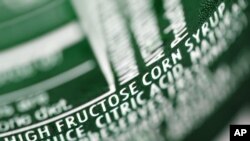There is new evidence that large amounts of high fructose corn syrup - a sweetener used in food products consumed around the world - could be a major factor in the accelerating global epidemic of type 2 diabetes, according to U.S. and British researchers.
A study by Michael Goran of the University of Southern California in Los Angeles and colleagues at Britain’s Oxford University concludes that countries that use high fructose corn syrup, or HFCS, in their food supplies have a 20 percent higher prevalence of diabetes on average than countries that do not use the sweetener. The researchers analyzed data from 42 countries that report their use of HFCS.
Goran, who directs USC’s Childhood Obesity Research Center, says those countries with food products that contain higher amounts HFCS have an average eight percent prevalence of type 2 diabetes. That compares to just 6.7 percent in countries that used no high fructose corn syrup. Goran says HFCS contains more fructose, or fruit sugar, than other sweeteners, such as sucrose or table sugar. HFCS is harmful, Goran believes, because the body processes it differently than other forms of sugar.
“There is evidence that it is taken up almost exclusively by the liver where it can be repackaged as fat and contribute to fatty liver, which contributes to insulin resistance and then to diabetes," said Goran.
High fructose corn syrup is added to processed foods because it is cheaper than other sweeteners so less is needed and, says Goran, it combines well with baking ingredients and gives cakes and pies a nice brown color.
Soft drinks contain more HFCS than most other products, but the sweetener can be found in nearly all processed foods, including cookies, rolls and other baked goods, cold cereals and even baby food.
John White is president of White Technical Research. Speaking for the Washington-based Corn Refiners Association, White says Goran’s study is flawed and inconsistent.
“For example, if you look at the United States that has 22 times the higher fructose corn syrup consumption than Malaysia, you should see a correspondingly higher incidence of diabetes. But Malaysia’s incidence of diabetes is actually ten percent higher," said White.
Earlier this year, U.S. federal regulators rejected a petition by corn growers to change the name of high fructose corn syrup to corn sugar, a name the growers believed would sound more appealing to consumers.
Meanwhile, researcher Michael Goran says he would like to see products with labels identifying the percentage of HFCS in them, in much the same way that fats are now identified on food packaging.
The article on high fructose corn syrup and diabetes is published in the journal Global Public Health.
A study by Michael Goran of the University of Southern California in Los Angeles and colleagues at Britain’s Oxford University concludes that countries that use high fructose corn syrup, or HFCS, in their food supplies have a 20 percent higher prevalence of diabetes on average than countries that do not use the sweetener. The researchers analyzed data from 42 countries that report their use of HFCS.
Goran, who directs USC’s Childhood Obesity Research Center, says those countries with food products that contain higher amounts HFCS have an average eight percent prevalence of type 2 diabetes. That compares to just 6.7 percent in countries that used no high fructose corn syrup. Goran says HFCS contains more fructose, or fruit sugar, than other sweeteners, such as sucrose or table sugar. HFCS is harmful, Goran believes, because the body processes it differently than other forms of sugar.
“There is evidence that it is taken up almost exclusively by the liver where it can be repackaged as fat and contribute to fatty liver, which contributes to insulin resistance and then to diabetes," said Goran.
High fructose corn syrup is added to processed foods because it is cheaper than other sweeteners so less is needed and, says Goran, it combines well with baking ingredients and gives cakes and pies a nice brown color.
Soft drinks contain more HFCS than most other products, but the sweetener can be found in nearly all processed foods, including cookies, rolls and other baked goods, cold cereals and even baby food.
John White is president of White Technical Research. Speaking for the Washington-based Corn Refiners Association, White says Goran’s study is flawed and inconsistent.
“For example, if you look at the United States that has 22 times the higher fructose corn syrup consumption than Malaysia, you should see a correspondingly higher incidence of diabetes. But Malaysia’s incidence of diabetes is actually ten percent higher," said White.
Earlier this year, U.S. federal regulators rejected a petition by corn growers to change the name of high fructose corn syrup to corn sugar, a name the growers believed would sound more appealing to consumers.
Meanwhile, researcher Michael Goran says he would like to see products with labels identifying the percentage of HFCS in them, in much the same way that fats are now identified on food packaging.
The article on high fructose corn syrup and diabetes is published in the journal Global Public Health.




